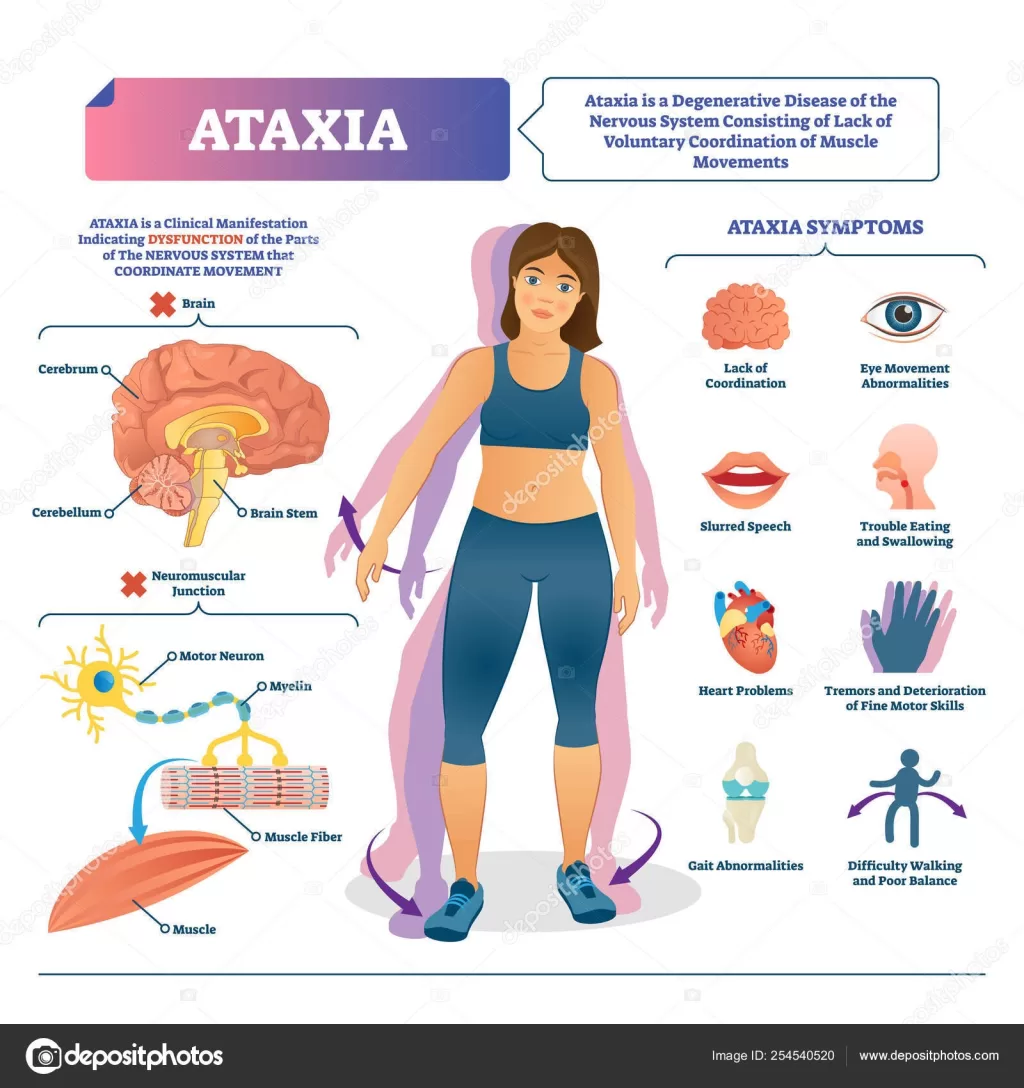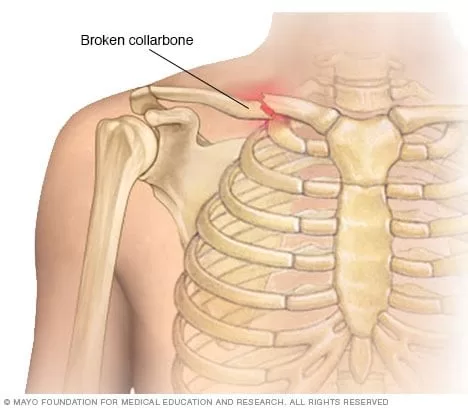Ataxia is a neurological disorder that significantly disrupts coordination and balance, leading to a range of debilitating symptoms. This condition can manifest in various forms, including Friedreich ataxia and spinocerebellar ataxia, each presenting unique challenges and treatment needs. Individuals suffering from ataxia often experience difficulties with movement, resulting in unsteady walking and impaired fine motor skills. Recent advancements in research are paving the way for innovative treatment for ataxia, including promising therapies aimed at specific types such as ataxia telangiectasia. Understanding the nuances of ataxia symptoms is crucial for early diagnosis and effective management, as ongoing studies continue to offer hope for improved outcomes.
Ataxia, often referred to as balance and coordination disorders, encompasses a spectrum of neurological conditions that hinder an individual’s ability to perform smooth and controlled movements. These issues can arise from a variety of underlying causes, including genetic factors and neurological diseases, leading to symptoms that vary widely among individuals. Terms like Friedreich ataxia and spinocerebellar ataxia highlight some of the specific classifications within this disorder, each requiring tailored approaches to treatment and care. As the medical community continues to explore innovative options for these conditions, understanding ataxia in its broader context becomes essential for both patients and healthcare providers. By recognizing the interconnected nature of ataxia symptoms and potential therapies, we can better equip ourselves to navigate the complexities of this challenging disorder.
Recent Advances in Ataxia Treatments
The field of ataxia research has witnessed significant progress in recent years, especially concerning the development of new treatment options. For instance, vatiquinone has emerged as a promising therapy for Friedreich ataxia, a hereditary form of the disorder. The FDA’s decision to prioritize its New Drug Application (NDA) indicates a growing recognition of the need for effective therapies to manage this debilitating condition. This advancement not only represents hope for individuals diagnosed with Friedreich ataxia but also highlights the urgency of addressing the treatment gaps in this area.
Similarly, the FDA’s recent priority review for the NDA of troriluzole presents another breakthrough for those suffering from spinocerebellar ataxia. This form of ataxia is particularly challenging to treat due to its complex nature, and the recognition of its treatment needs is a positive step forward. These developments underscore the importance of ongoing research in ataxia, as they pave the way for more effective interventions that can enhance the quality of life for patients across various types of ataxia.
Understanding the Symptoms of Ataxia
Ataxia is characterized by a range of symptoms that can significantly impact an individual’s daily life. Common symptoms include unsteady walking, poor balance, and difficulties with fine motor skills. These manifestations can vary widely depending on the specific type of ataxia diagnosed. For example, individuals with Friedreich ataxia might experience more pronounced difficulties with coordination, while those with ataxia telangiectasia may also face additional complications such as increased cancer risk.
Recognizing these symptoms early is crucial for effective management and intervention. Healthcare providers often conduct comprehensive assessments to evaluate the extent of coordination issues and other related symptoms. By understanding the diverse presentations of ataxia, patients and caregivers can work together to develop appropriate management strategies that cater to the individual’s unique needs, ultimately improving their quality of life.
Exploring the Types of Ataxia
Ataxia is not a one-size-fits-all disorder; it encompasses several distinct types, each with unique characteristics and implications. Ataxia telangiectasia is a rare genetic disorder that not only leads to progressive neurological decline but also poses a heightened risk for certain cancers. This complexity necessitates specialized care and monitoring for affected individuals, emphasizing the need for a tailored approach to treatment.
On the other hand, cerebellar ataxia is primarily linked to conditions that disrupt the cerebellum’s function, resulting in pronounced issues with muscle control and coordination. Understanding these different types of ataxia is critical for healthcare professionals and patients alike, as it guides the selection of targeted therapies and interventions that can help manage symptoms effectively.
Ataxia in Non-Human Animals
Ataxia is not limited to humans; it can also occur in animals, particularly in pets like dogs and cats. Veterinarians often face challenges in diagnosing ataxia in animals due to the variety of potential underlying causes, which can include hereditary conditions, infections, or exposure to toxins. A thorough evaluation is essential to determine the specific nature of the ataxia and to implement an appropriate treatment plan.
The presence of ataxia in animals serves as a reminder that this disorder can affect a wide range of species. Understanding the signs of ataxia in pets, such as difficulty walking or loss of coordination, can lead to early intervention and improved outcomes. As veterinary medicine continues to advance, enhancing diagnostic techniques and treatment options for ataxia in animals holds promise for better management of this challenging condition.
The Future of Ataxia Research and Treatment
The future of ataxia research appears promising, with ongoing clinical trials and advancements in understanding the disorder’s underlying mechanisms. Recent studies, such as the ATTeST trial for ataxia telangiectasia, highlight the dedication of the medical community to uncover effective treatments. These developments not only aim to alleviate the symptoms of ataxia but also seek to address the root causes of the disorder, thereby offering a more comprehensive approach to management.
As researchers continue to explore innovative therapies and drugs, the hope is that these advancements will translate into tangible benefits for individuals affected by ataxia. The collaboration between scientists, healthcare providers, and patient advocacy groups plays a crucial role in accelerating this progress, thereby fostering an environment where new treatments can emerge, ultimately enhancing the quality of life for those living with ataxia.
Frequently Asked Questions
What are the common symptoms of ataxia and how do they affect daily life?
Ataxia symptoms typically include unsteady walking, poor balance, and difficulty with fine motor skills. These symptoms can significantly impact daily life, making tasks such as writing, buttoning clothes, or even standing challenging. Understanding these ataxia symptoms is vital for early diagnosis and effective management.
What is Friedreich ataxia and what are its treatment options?
Friedreich ataxia is a hereditary disorder characterized by progressive loss of coordination and balance, primarily affecting children and young adults. Recent advancements in treatment include the FDA’s priority review of vatiquinone, which aims to improve the quality of life for those affected by this condition.
How is spinocerebellar ataxia diagnosed and treated?
Spinocerebellar ataxia (SCA) is diagnosed through clinical evaluation, genetic testing, and imaging studies. Current research has led to the FDA granting priority review for the drug troriluzole, which may offer new treatment options for adults suffering from SCA. Early diagnosis and tailored treatments can help manage symptoms effectively.
What is ataxia telangiectasia and how is it different from other types of ataxia?
Ataxia telangiectasia is a rare genetic disorder that causes progressive neurological decline and increases cancer risk. Unlike other types of ataxia, it also impacts the immune system and is associated with telangiectasia or small dilated blood vessels. Understanding its unique characteristics is crucial for appropriate management and treatment.
What recent advancements have been made in ataxia research?
Recent advancements in ataxia research include the FDA’s priority reviews of promising drugs like vatiquinone for Friedreich ataxia and troriluzole for spinocerebellar ataxia. Additionally, ongoing clinical trials, such as the ATTeST Trial for ataxia telangiectasia, are exploring new treatment methodologies, providing hope for improved therapies in the future.
| Key Point | Details |
|---|---|
| Definition of Ataxia | A group of neurological disorders that affect coordination and balance. |
| Recent Research Updates | Advancements in treatments like Vatiquinone and Troriluzole for specific types of ataxia. |
| Symptoms of Ataxia | Includes unsteady walking, poor balance, and difficulties with fine motor skills. |
| Types of Ataxia | Includes Ataxia Telangiectasia and Cerebellar Ataxia, each with unique characteristics. |
| Ataxia in Animals | Pets can also suffer from ataxia, necessitating veterinary evaluations. |
| Related Topics | Differences between ataxia and apraxia, as well as cultural references in gaming. |
Summary
Ataxia is a complex disorder characterized by a lack of muscle coordination and control, significantly impacting those affected. Recent advancements in ataxia research have introduced new treatment options, such as Vatiquinone and Troriluzole, which offer hope for individuals with specific types of ataxia. Understanding the disorder’s symptoms and types, including Ataxia Telangiectasia and Cerebellar Ataxia, is crucial for effective management. Furthermore, ataxia is not limited to humans; it can also affect pets, highlighting the importance of comprehensive evaluations by veterinarians. As research continues to evolve, the future of ataxia management looks promising, providing hope for better therapies and improved quality of life for those impacted.
The content provided on this blog (e.g., symptom descriptions, health tips, or general advice) is for informational purposes only and is not a substitute for professional medical advice, diagnosis, or treatment. Always seek the guidance of your physician or other qualified healthcare provider with any questions you may have regarding a medical condition. Never disregard professional medical advice or delay seeking it because of something you have read on this website. If you believe you may have a medical emergency, call your doctor or emergency services immediately. Reliance on any information provided by this blog is solely at your own risk.








